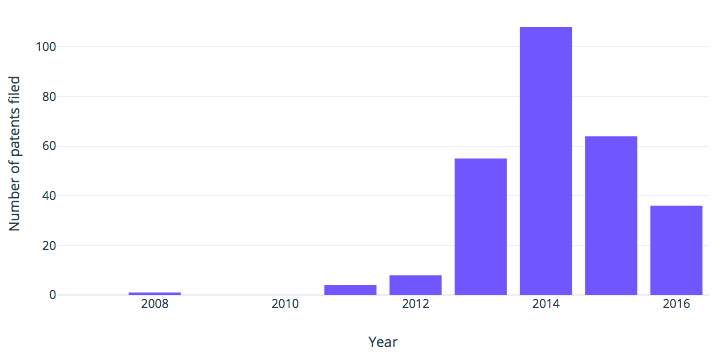15 Mar 2019
We’re starting a blog series that examines how successful startups have approached the patent process, and how those strategies dovetail with our discussions in earlier blog posts about crafting a smart patent strategy. Last month, we kickstarted the series with a deep dive into Uber’s patent portfolio.
This month, let’s take a closer look at FitBit, a company whose name has become synonymous with the fitness tracker industry. FitBit went public in 2015 — a move supported by a strong foundation of IP built during the company’s early years.

WHAT IS FITBIT?
Founded in 2007, FitBit specializes in wearable technology devices that track physical activity.
FitBit achieved early market dominance in the wearables industry. In 2014, Forbes reported that FitBit owned 50 percent of the market for digital fitness devices, as well as 77 percent of the market for full-body activity trackers.
FitBit also developed some of the first commercially successful fitness trackers. In their 2014 ranking of fitness trackers, TIME Magazine ranked the FitBit Force and FitBit One as first and second respectively.
Through these early successes, FitBit achieved strong brand recognition, which enabled the company to go public via an initial public offering (IPO) in 2015.
Today, FitBit continues to thrive: According to MacroTrends, FitBit is valued at $1.38 billion as of Feb. 5, 2019. And in terms of market share within the global wearables industry, our research has shown that FitBit is ranked third, just behind Apple and Xiaomi.
AN OVERVIEW OF FITBIT’S PATENT PORTFOLIO
As of January 2019, FitBit has been assigned 293 U.S. patents according to patent office records. That means their patent portfolio is relatively small compared to most major tech companies, who typically obtain hundreds or thousands of patents per year.
According to data from Innography, FitBit appears to have had very little patent activity in its early years, but then ramped up its patent filings in 2013 and 2014, just before its IPO in 2015:
FitBit’s U.S. patent filings between 2007 to 2014

FITBIT’S APPROACH TOWARD ITS PATENT PORTFOLIO: EARLY YEARS TO IPO
Let’s analyze what the Innography data tells us — and back that up with a quick look at some of FitBit’s early patent filings.
FitBit kept its patent portfolio relatively small for several years. Apparently, FitBit filed virtually zero patent applications in its earliest years (2007-2009), then started playing catch-up with their patenting efforts, starting with a couple of foundational U.S. provisional applications filed in 2010.
FitBit followed its 2010 provisional applications with a related non-provisional filing in 2011, a few months before the release of the FitBit Ultra. And then there’s a sprawling network of related U.S. patent filings over several years (dozens of divisionals, continuations, etc.) that all claim priority back to the non-provisional filing from 2011 and the related 2010 provisionals.
The earliest U.S. patent that lists FitBit as the assignee (U.S. Patent No. 8,180,591) was issued in 2012, based on the two provisional filings from 2010. In other words, it appears that FitBit’s first issued U.S. patent was based on a patent application filed three years after the company was founded, and over a year after they released their first product.
After 2011, FitBit’s patent filing volume steadily climbed year-over-year until their IPO in 2015. Based on the numbers alone, it’s clear that FitBit made a huge investment in patent filings to support its IPO. Looking at FitBit’s issued patents, the company went from about ten patent application filings in 2012 to about 100 patent application filings in 2014. That’s a ten-fold increase in just two years!
FitBit’s pivot from virtually zero patent filings in its earliest years to over 100 patent filings in 2014 (according to the Innography data above, which is consistent with our review of USPTO records) strongly suggests that FitBit made a hard pivot in its patent strategy, perhaps based on lessons learned in the market.
WHAT IS FITBIT PATENTING?
According to iRunway, the type of technology FitBit has sought utility patents for can be broadly sorted into three categories:
- Hardware: Sensors and monitors that track critical physical data, such as the user’s vitals and environmental indicators.
- Software: Apps that typically monitor the user’s activity and statistics, with a smaller focus on alerts and goal management.
- Data management: Any technology that communicates, analyzes, and processes data collected through the sensors.
Finally, it’s worth noting that a significant portion of FitBit’s patent portfolio consists of design patents, which underlines the fact that FitBit’s innovation has covered the realms of both fashion and technology.
Design patents cover the distinctive ornamental appearance of a product (rather than the product’s innovative functionality). So FitBit has apparently placed high importance on the distinctive appearance of its products, with approximately 20% of their U.S. patents being design patents.
FITBIT’S PATENT STRATEGY: WHAT LESSONS CAN YOUR STARTUP LEARN?
In 2015, FitBit achieved a successful exit via an IPO. Let’s examine how its patent strategy helped the company lay the right foundation for going public — and what other tech startups can learn from FitBit’s approach.
WHAT CAN EARLY-STAGE TECH COMPANIES LEARN FROM FITBIT’S APPROACH?
There are two key lessons that tech companies can glean from a quick look at FitBit’s patent filings over the years leading up to their IPO:
First, FitBit’s earliest patent filings served as a foundation for a significant portion of the company’s patent portfolio going into their IPO. Throughout the (ongoing) life of FitBit’s patent portfolio, many of their patent properties continue to claim priority back to their earliest provisional applications filed in 2010.
In fact, based on a search of the USPTO patent database, it appears that as many as one quarter of FitBit’s issued U.S. patents refer back to their two 2010 provisional filings.
Second, FitBit may have arrived late to the patent game, but they clearly recognized the importance of building a large patent portfolio to support a successful IPO. The good news is that they succeeded, which shows that it’s never too late to get started building your patent portfolio.
WHAT WERE FITBIT’S PATENTING PRIORITIES?
As FitBit grew its portfolio over the years, they understood that they needed to own a future share in a new market, and so they took steps to aggressively grow and protect the relevant technology.
According to an analysis by PatSnap, FitBit’s patent strategy prioritized tech diversification as well as science-driven research and development efforts, which enabled FitBit to focus on developing more sophisticated products. And this matches our perspective that startups need to play offense with patents.
Finally, as PatSnap also discusses, FitBit was focused on building a U.S. portfolio, with less emphasis on foreign protection. We’ve previously cautioned startups to tread with care when considering an international patent strategy, as it’s costly to file in multiple jurisdictions.
It’s likely that FitBit took a considered approach in determining where their technology would be most valuable, as well as where their patents could best be enforced.
These tactics enabled FitBit to edge out close rivals like Jawbone, which went under in 2017. According to PatSnap, Jawbone’s patent portfolio was about twice as large as FitBit’s, as Jawbone tried to build a more international portfolio that prioritized market-driven and joint R&D.
OPEN QUESTIONS: DID FITBIT’S MISS EARLY OPPORTUNITIES?
A quick look at FitBit’s patent portfolio also raises a couple of questions, which we won’t attempt to answer here, but growing tech companies might do well to consider for themselves:
- How much valuable IP did FitBit inadvertently give up by failing to file more patent applications earlier in the life of their company, before they released their first products?
- Could FitBit have retained their top market position if they had filed more high-quality patent applications earlier in the life of their company, before they released their first products?
According to the timelines we’ve found (here and here), FitBit released their first product (the FitBit Tracker) in 2009, and apparently didn’t have any significant patent applications filed before the launch. As noted above, FitBit’s foundational provisional patent filings were filed in late 2010.
As any patent attorney (and our astute readers) will appreciate, the timing of FitBit’s late-2010 patent filings means that FitBit probably wasn’t able to get patent protection for any of the innovative features of their 2009 product.
Although their patent portfolio has been strong enough to support a successful IPO and continued growth over the years, it’s possible that a more proactive patent strategy early on would have had a major (positive) impact on FitBit’s market position today.

FITBIT’S MORE RECENT APPROACH TOWARDS PATENT ACQUISITIONS
FitBit has also been expanding its portfolio by acquiring promising companies in adjacent spaces.
The Motley Fool has reported on FitBit’s desire to integrate its products and programs into healthcare systems. FitBit’s major acquisitions seem well-aligned with that goal:
- 2015: Fitstar, a fitness coaching app
- 2016: Coin, a smart credit card (FitBit acquired the IP but not the hardware)
- 2016: Pebble, a wearables company (the deal excluded hardware)
- 2017: Vector Watch, a smartwatch brand
- 2018: Twine Health, a cloud-based collaborative healthcare platform
KEEPING PACE WITH THE CHANGING MARKET FOR SMARTWATCHES
In recent times, the wearables industry — in particular, that of fitness trackers and smartwatches — is seeing increasing competition and changing consumer needs. We discuss this trend in greater detail in our blog post about the patent landscape for wearables technology.
So FitBit, who is currently ranked third in the global market, will need to continue innovating in order to stay competitive. And FitBit appears to be taking these challenges seriously: The company is regaining its footing thanks to new products like the FitBit Versa.
LOOKING TO PATENT WEARABLES TECHNOLOGY?
Got valuable wearables technology on your hands? You’ll want to pursue a patent strategy that’s aligned with your business goals, as well as the current state of the industry.
That’s why we recommend consulting an experienced legal professional who can help you work out your next steps. The team at Henry Patent Law Firm is ready to help — contact us now.

Michael K. Henry, Ph.D.
Michael K. Henry, Ph.D., is a principal and the firm’s founding member. He specializes in creating comprehensive, growth-oriented IP strategies for early-stage tech companies.

